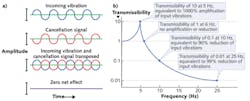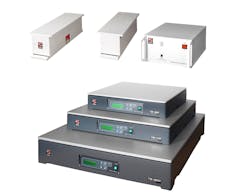VIBRATION CONTROL SYSTEMS: Active vibration isolation: Know the options
Active vibration isolation systems for photonics applications use a combination of sensors and actuators whose functioning is controlled by articulated algorithms to attenuate vibrations. The algorithms are stored in either an external or internal controller that acts as the "central command" for the system. The sensors detect vibrations along specific directions (x, y, and z) in the platform and send this information to the controller. The controller in turn sends a signal to the transducers, which act on the platform to reduce the sensed vibrations (see Fig. 1).
Most sensors found within active isolation systems are capable of detecting parameters such as displacement, velocity, and acceleration. These systems often use a combination of passive and active isolation technologies. The passive-isolation component of the platform attenuates vibrations within the higher frequency range (100 Hz and above), whereas the active-isolation component focuses on the lower frequency range (0 to 100 Hz) to attenuate the natural low-frequency resonance found within passive isolation systems. In addition to reducing such resonances, most active isolation systems are capable of canceling translational and rotational modes of vibration in all six degrees of freedom.
Feedback vs. feed-forward control
There are two primary categories that describe active isolation systems: feedback and feed-forward control systems. A feedback control system continuously monitors the platform it is controlling and modifies its output according to the vibration data retrieved. In a feedback active-control system, the forces causing the vibrations (arising from the environment, experimental devices, and so on) are measured, and the control system sends out-of-phase signals to the transducers in a feedback loop to reduce measured amplitudes. These feedback control systems are reactive, modifying the isolating behavior of the active-isolation system based on the input measured.
In contrast, a feed-forward control system is anticipative in nature wherein the control system responds in a predefined way to control the input vibrations. This type of control system is deployed when the behavior of the controlled variable (for example, forces) is well understood. In these active-isolation systems, feed-forward control loops are used to attenuate onboard vibrations (for example, large moving stages). The feed-forward system already has information about the stage motion and applies the necessary forces to counter the vibrations.
Advantages of active isolation
An active isolation system has two main advantages over a passive isolation system: low-frequency isolation and increased stiffness. To achieve increased low-frequency vibration isolation, an active isolation system cancels low-frequency resonances via its closed-loop design. Resonance occurs when the frequency of the force input matches the natural frequency of the system, leading to high amplitudes of oscillation at those frequencies. Tall buildings, as well as buildings built near subways, waterways, or on reclaimed land, often have resonances below 10 Hz and can oscillate dangerously if mounted on a passive system. Generally, when evaluating vibrations, the amplitudes of oscillation at lower frequencies tend to be higher than those observed at higher frequencies.
Active isolation systems are approximately 100 times stiffer than passive pneumatic isolation systems. The stiffness characteristics of an active isolation system offer much greater directional and positional stability for an instrument or application. This added stiffness also allows for a more stable setup, which is helpful when a laser beam is directed off the isolation platform.
Options for active vibration isolation
Active vibration isolation systems have many options that vary depending on the manufacturer of the system and the intended use of the platform; some examples follow:
Automatic load adjustment. This is a unique feature often found in compact desktop vibration isolation platforms. This option automatically adjusts the system configuration based on the load and its distribution over the platform, removing any need for installation procedures or persistent maintenance over the lifetime of the platform. Automatic load-adjusted platforms are valuable in laboratory environments where multiple users are operating an instrument, or if the weight and/or weight distribution fluctuate over the operation of the platform.
Low-frequency compensation. Complementary performance-upgrade systems can also be used in conjunction with active isolation systems. A separate feed-forward low-frequency sensor can be paired with a feedback isolation platform, enabling the platform to provide better low-frequency isolation performance. These feed-forward sensors have high sensitivity in the low-frequency vibration range, more effectively attenuating vibrations within this range and providing sub-hertz vibration isolation when well executed.
Signal monitoring. Active isolation systems are constantly sensing vibrations as they operate, which allows the user to externally monitor the vibration noise and vibration isolation performance of the platform. External monitoring systems are often available as a simple upgrade that connects through the controller of the vibration isolation platform.
Shaker. The actuators of an active isolation system are most commonly used to attenuate vibrations from the environment; however, these actuators can also be used as shakers that can input forces (vibrations) into a system. These are typically lower-amplitude devices, but the shake is superimposed on the isolated system and is therefore independent of the environment.
Considerations in choosing an active-isolation system
Cost. Due to their more complex and technical design, active isolation systems are often more costly than passive isolation systems. The array of sensors and actuators embedded in each system, along with the various control systems monitoring the signals, require complex processing systems that can elevate the price of each active vibration isolation platform. Passive vibration isolation systems have a simpler design that does not require electrical components or carefully calibrated sensors. They can provide isolation for applications or environments with no low-frequency (less than 5 Hz) requirements for isolation.
Installation. The amount of time required for installing an instrument or application onto a platform is a function of the form factors of the particular type of active vibration isolation system supporting it. Some active isolation systems are broadband (work over a wide range of frequencies) and do not require tweaking of the control loop during the installation, whereas other systems are tuned for a specific payload and weight distribution. Advantages of not having to tune a platform during installation or after changes have been made to the platform give end users the opportunity to focus on their research rather than their isolation system.
Form factor. Active isolation systems come in a variety of sizes and load capacities, being able to support loads from less than one to thousands of kilograms (see Fig. 2). Passive isolation systems generally use pneumatic air isolation "pucks" to isolate vibrations. The volume of air used for isolation increases nonlinearly as the desired isolation frequency lowers. Active isolation systems are typically more compact than passive systems because they do not need large volumes of air to isolate vibrations at lower frequencies. Another choice to be made is whether to integrate the control unit into the platform itself or to use an external control unit that connects via cabling. Platforms incorporating internal control systems are often more compact than external control systems; however, external control systems often allow for a modular, scalable platform setup.Low-frequency performance. When choosing an active vibration isolation system, it is important to consider the low-frequency performance of the platform and whether it is capable of achieving the same vibration isolation performance for all translational and rotational modes of vibration. Manufacturers may represent the performance of the platform based only on the axis for which it provides the most attenuation, which at times can be misleading. It is recommended to request the performance for all axes in which the platform attenuates to better determine its overall effectiveness.
Active leveling vs. active vibration isolation. An important distinction to be aware of is the difference between "active leveling" and "active vibration isolation" systems. Active leveling systems use passive isolation technology (such as air), but have automatic leveling included to compensate changes in the load. The product will thus be marketed as an active-isolation product, whereas in fact the platform is a passive-isolation product. The distinction between active leveling and active vibration isolation is something to keep in mind when considering which vibration isolation platform to purchase.

